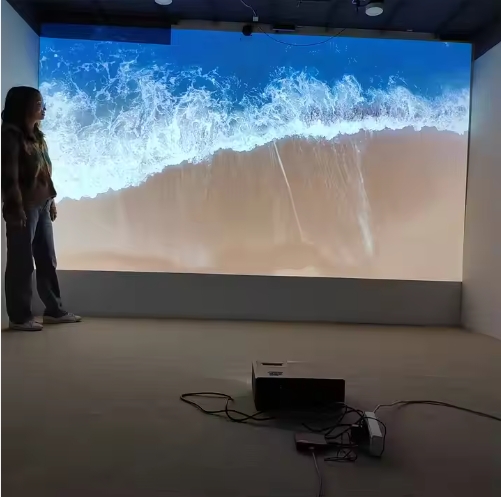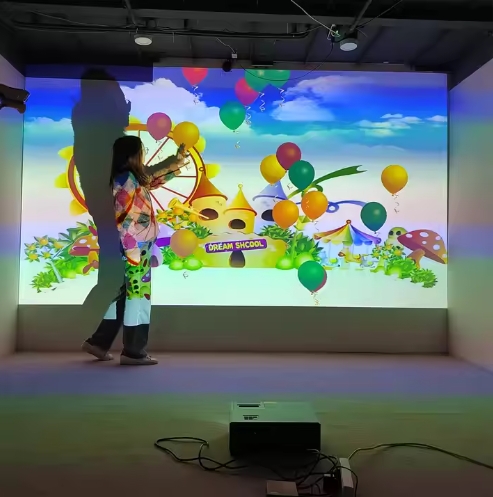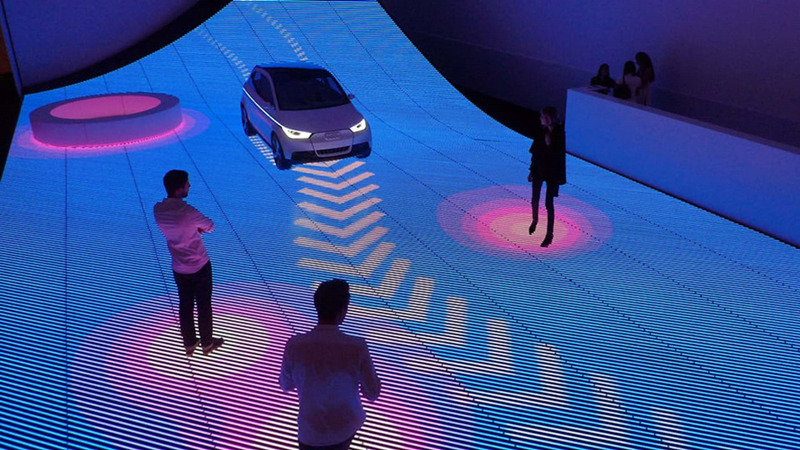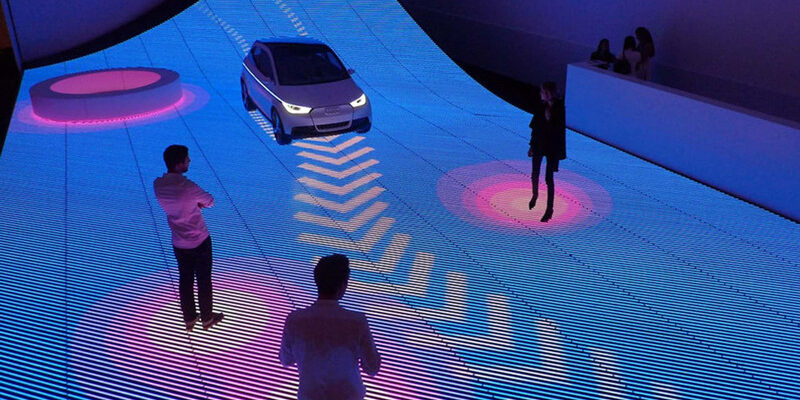Introduction
Ground interactive projection is transforming various fields, from entertainment and education to advertising and science exhibitions. By allowing users to interact directly with visuals on the floor, this technology creates immersive experiences that engage audiences in unique and memorable ways. The integration of LiDAR (Light Detection and Ranging) adds precision and responsiveness, enhancing the interactive experience. In this article, we’ll explore the main applications of ground interactive projection and describe the interactive forms enabled by LiDAR—such as ripple effects, flipping, collision, and erasing effects—that captivate audiences and boost engagement.

Key Application Scenarios of Ground Interactive Projection
Ground interactive projection systems have been adopted across a variety of settings, each using the technology to create unique and meaningful interactions:
1. Entertainment
In entertainment venues, such as arcades and event spaces, ground interactive projection enhances activities and games. Using LiDAR’s motion-sensing capabilities, games can respond instantly to player movements, creating a more engaging experience. For example, an interactive floor game may have players “step” on digital tiles to score points, with LiDAR accurately tracking each movement in real time. This enables precise feedback, which is crucial in fast-paced gaming environments, ensuring the experience is immersive and intuitive.
2. Education
Educational institutions and museums use ground interactive projection to create hands-on learning experiences. In science centers, for example, children can “walk” through a virtual solar system, stepping on planets or constellations to reveal information or animations. With LiDAR, interactions are tracked with high accuracy, making it possible to offer detailed responses for each step, gesture, or movement, which enhances engagement and understanding. These interactive floors make learning more active and enjoyable, encouraging children to explore and interact with complex information in a tangible way.
3. Advertising
Brands and retailers leverage ground interactive projection to attract and engage customers with captivating visual displays. For instance, in a shopping mall, an interactive floor display might feature product images that “react” when customers step on them, perhaps by showing product details or special offers. LiDAR enables these interactions by precisely detecting where customers are standing or moving, allowing the system to deliver targeted messages in real time. This interactivity encourages more engagement, turning advertising into an experience rather than a passive observation.
4. Science Exhibitions and Public Installations
In science exhibitions or public spaces, interactive projection floors provide informative and visually appealing displays that attract a wide audience. Imagine a virtual aquarium projected on the floor of a public space, where visitors can “stir” the water or “scatter” fish with their movements. Using LiDAR’s precise motion-capture ability, these systems ensure accurate responses, creating lifelike interactions that capture visitors’ interest. This makes LiDAR-enhanced projections ideal for educational exhibitions or public art installations, where they add an element of discovery and engagement.

Forms of Interaction Enhanced by LiDAR
LiDAR enhances the interactive experience of ground projection by enabling various effects that respond accurately to user movements. Here are some of the popular interaction forms and how they elevate the audience experience:
1. Ripple Effects
Ripple effects are commonly used in water-themed interactive floors, where users’ steps create ripples that spread across the projected “water” surface. With LiDAR, each ripple’s origin and intensity can correspond precisely to the location and force of the user’s movement, making the interaction feel authentic and visually pleasing. This effect is popular in retail and entertainment, where it provides a calming yet engaging experience as people walk across the projection.
2. Flipping and Revealing Content
Flipping effects allow users to “flip” images or “reveal” new content with their movements. For example, stepping on a projected “tile” might flip it to reveal a hidden image or message. LiDAR’s accuracy allows the system to detect exactly where users are interacting, ensuring the flip happens instantly and correctly. This effect is often used in educational and advertising contexts, where it allows audiences to uncover information interactively, creating a sense of exploration and discovery.
3. Collision Effects
In interactive projection games, collision effects simulate physical interactions between digital objects and the user. For instance, in a soccer-themed game, users can “kick” a projected soccer ball that reacts by moving or bouncing across the floor. LiDAR’s precise tracking makes these interactions possible, capturing users’ exact locations and translating their movements into on-screen reactions. This effect is especially popular in entertainment settings, as it allows for dynamic, action-oriented interactions that feel realistic and engaging.
4. Erasing and Drawing Effects
Some interactive floors enable users to “erase” or “draw” on the projected surface by moving across it. For example, in an art exhibit, users might walk across a blank “canvas,” leaving a trail of digital paint as they go. Or they might “erase” parts of a projection to reveal a new image beneath. With LiDAR, each movement is precisely tracked, ensuring the “drawing” or “erasing” happens in the exact spot where the user is standing. This interaction form is popular in artistic and educational settings, where it encourages creativity and exploration.

Conclusion
Ground interactive projection is revolutionizing how we engage with digital content in physical spaces, making interactions dynamic and immersive. Through the integration of LiDAR, these systems achieve a new level of precision and responsiveness, enabling ripple effects, flipping, collisions, and more to occur with high accuracy. Each interaction type not only captivates users but also transforms spaces into interactive canvases that invite exploration, engagement, and learning.
Whether in a retail store, a museum, or an event space, LiDAR-enhanced ground projection systems deliver memorable experiences, inviting audiences to engage with the digital world in a hands-on way. As this technology continues to evolve, we can expect even more creative applications and interaction types, making ground interactive projection a versatile tool for transforming spaces across industries.
By discussing these applications and interaction types, this blog post highlights how LiDAR-driven ground interactive projection brings ideas to life in practical, memorable ways, appealing to a wide audience and offering boundless possibilities for engagement.







